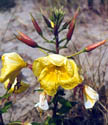 The Evening Primrose was brought to England in 1614 as a botanical curiosity. It is a biennial plant that only opens its bright yellow flowers in the evening, June to October, when moths find it particularly attractive (the petals emit a phosphorescent light at night). Member of the Willow-herb family. It will grow to a height of about 2 ft 6in (80 cm). Known as Night Candle in Germany. Also known as Night Willowherb, Scabish, Wild Beet and King's Cure-All.
The Evening Primrose was brought to England in 1614 as a botanical curiosity. It is a biennial plant that only opens its bright yellow flowers in the evening, June to October, when moths find it particularly attractive (the petals emit a phosphorescent light at night). Member of the Willow-herb family. It will grow to a height of about 2 ft 6in (80 cm). Known as Night Candle in Germany. Also known as Night Willowherb, Scabish, Wild Beet and King's Cure-All.Found naturally in waste ground. Produces seeds that are attractive to birds. Food plant of the Elephant Hawk moth - Evening Primroses rely on moths for pollination. A herb with many medicinal uses and also the root and leaves can be eaten. Plant was a staple food for many Native American Indian tribes. Name comes from the Greek "oinos", meaning wine, and "thera" (hunt) because of belief in its ability to cure hangover.
It was believed in ancient times to be able to rid one of a hangover! Since the flowers open at dusk and close again at noon the next day, the plant was believed to be a witch's herb and used in spells. The whole plant can be soaked in warm water to make a skin poultice.
Evening Primrose is used to treat PMS, dermatitis, high cholesterol, asthmatic cough, psoriasis. Some people believe it has anti-cancer properties. The oil contains two essential fatty acids which play a key role in biological processes and, for this reason, it is believed to be a useful herb. Has also been used in the past to treat whooping cough.
Plant out in dry soil. Will tolerate sandy soil too. It prefers a sunny position with shelter from winds, disliking cold, damp sites.
Cut back in late September once seed has dropped and divide every three years in Spring.
*This sheet is provided for information only and is in no way a prescription for use. Please seek the advice of a qualified herbalist before using*